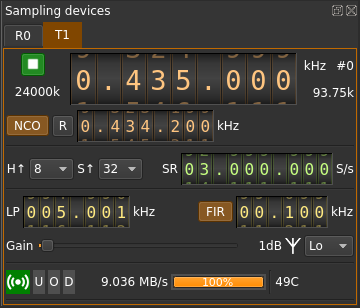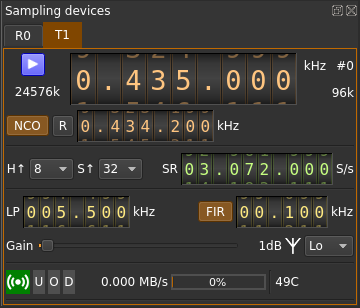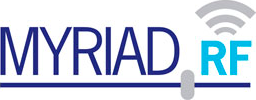So far, Marty, I have only tried NFM on 2M.
OK. 25MHz, AM, gain set to 60db. Output into tester/SpecAn. perfect 1KHz modulation. Signal -17db. Like .02mW. Something is limiting the power. This is much stronger further up the spectrum.
I think I will run a sweep with a single tone like that for about 50MHz and see how it outputs through the range.
Just did that.
Gain set to 45db. No tone, just carrier.
30MHz,-5.2
25MHZ,-28
20MHz,-50
15MHz,-63.2
The whole time a sizable carrier remains at 30MHz. I was interrupted and can’t get back to this for a while.
It happens at any frequency, either direction. The more the NCO deviates from the LO, the lower the carrier.
I did a receiver test. I injected a 30MHz sine wave at different levels to see how the input chain responds. Pretty good.
With a 25 uV input I tuned to 30.1MHZ and zoomed in on the signal. With TIA at 1, LNA at 30, the PGA can by turned up and down for signal level. If the TIA is turned up a spur appears at the mirror of the LO, in this case 30.2MHz. 25 uV is 55db above the noise floor. 1 uV is still 20db above the floor. The smallest signal I can output is .063 and that still is 15db up. I am using the spectrum display on sdrangel for measurements.
Just rebuilt …
Im not sure what the selectiin in the gain control of (1,2,3) does when set to manual … but in manual mode i can rx WWV finally …
For my Odroid-C2 i can set sample rate of 3500k … and can set nco all the way down to 2000000 …
Looking better … !!!
Didnt get a chance to figure out how to switch from AM to SSB when they are both in the pannel … wife called , looking for me – time was up.
I just confirmed that the receiver works the same as the transmitter when NCO is engaged. The farther away from the LO frequency the NCO is set, the lower the received signal is.
How is affected when the lpf is set to 100mhz as opposed to 30mhz (or lower)
Interesting. I had the lpf set to 25MHz, which should be out of the effected range. It has a pronounced effect though. After the filter is above 45 it starts to get out of the way. There is still a decrease as you move away from LO with NCO but it is not as bad. This is the same on Tx and Rx.
On another point. Changing things on the fly often leads to unpredictable results and mixed up states. I often have to reset sdrangel and the Lime. Sometimes I can press the reset button on the lime and sometimes I need to power cycle it. I can close and restart sdrangel to reset it.
Ok … i thought the Q or edge of the low pass filter was not all that sharp …
Hello Edouard,
Great app this is !
I also try to use the hackrf in the programm but it isn’t available in the pull down list.
Is it possible that the libhackrf.dll is not okay?
If that is the case, have you a suggestion to get the right one ?
Regards Ben
Hello,
mind the LPF filter (that’s the LP with yellow numbers). It tunes the internal low pass filter that sits after NCO mixing and hardware interpolation before the DAC if I got the LMS7002 specs right. Thus it can indeed reduce the signal as it goes far away the LO frequency. The response charts are in the specs. If I remember right the slope is not as sharp as with the FIR.
Best regards, Edouard.
Hello,
didn’t take time to read everything in details since the last time I read this thread. A lot has been going on… I just would like to say (particularly to Marty who found it first) that indeed the input from the mic (or the live input source) is very bad. And this is not a problem with the mic since recording with the same device and playing back the file as the file source in the modulator gives a correct audio. It is the same with all audio modulators: AM, NFM, SSB so I guess this is a problem with the interfacing with QAudioDevice in the AudioInput object. On the output side the code seems much more complex so my implementation on the input side is maybe too simplistic.
I tried to look at the magnitude of the signal in AM with the channel analyzer so I could see the waveform and it looks like it is modulated at higher frequency. This may indicate that the bytes are not put in the correct order.
I am going to open an issue for that (https://github.com/f4exb/sdrangel/issues/43).
Note: this seems to happen when the channel sample rate is equal to twice the audio sample rate (hence 96 kS/s) and higher so a workaround is to keep the channel sample rate between 48 kS/s inclusive and 96 kS/s exclusive. This does not work with WFM because audio is always interpolated at 384 kS/s before modulation.
As an example this setup works around the problem for AM, NFM, SSB since the channel sample rate is 93.75 kS/s thus +/- 48 kHz spurs are also rejected:

Note: problem found. Fixed in future version 3.5.4 now in dev branch.
Note2: v3.5.4 has just been released.
Best regards, Edouard.
Hi Ben,
speaking of .dll I guess you’re in Windows. The libhackrf.dll that ships with the archive should be OK. At least it should be OK as long as you have the 17.02.1 version of the firmware (was recompiled for it in 3.4.1).
Other reasons may be that the system does not see the HackRF at all. Have you tried to run it with a different SDR program?
Best regards, Edouard.
Hello Marty,
These are the settings I use to test SSB on UHF:

To avoid mic input issues (see above). The only difference is the host to device rate set at 3 MS/s:

A few things to notice:
- I don’t need such a large IF shift compared to HF just moving a bit away from the LO (here -800 kHz). It actually transmits at 434.200 MHz (no need to apply the IARU rules inside the shack
 )
) - In a first attempt I tried to reach a 48 kS/s at the modulator (soft decimation by 64) but noticed fairly large images at +/- 48 kHz from the main transmission. So I reduced decimation to 32 thus having a
9693.75 kS/s sample rate at the modulator. Then the FIR at 100 kHz sharply cuts all possible spurs (the FIR is a really nice feature of the Lime). I notice an increase on the noise floor 100 kHz around the (missing) carrier but the Rx (a RTLSDR) is very near. - The Tx gain is indeed quite low at +1dB.
Best regards, Edouard.
Hello,
I see it can run on an Odroid C2, that’s interesting. I was wondering which ARM64 platform could run it.
In fact you don’t need to switch because they both run concurrently. You can mute either audio with the respective “mute” buttons.
Best regards, Edouard.
Ok … i did see that …
Iv tried to switch from usb to lsb … i was listening to a known lsb conversation on 3.988mhz (on another reciver) and i tried setting NCO above the conversation and below … with DSB sure i can … but also another coversation 3khz away.
Need more controll over TIA gain too …
LSB is obtained by pulling the BW filter limit in the negative frequencies
Ok, easy enough …
How about being able to slow down the waterfall …
It shows about 1/5th of a second from top to bottom …
Hey marty,
How is your Rx delay?
Mine sounds about 2 sec behind my UHFSDR(Odroid-X2 - Quisk ~30mS) When listening to WWVH.
